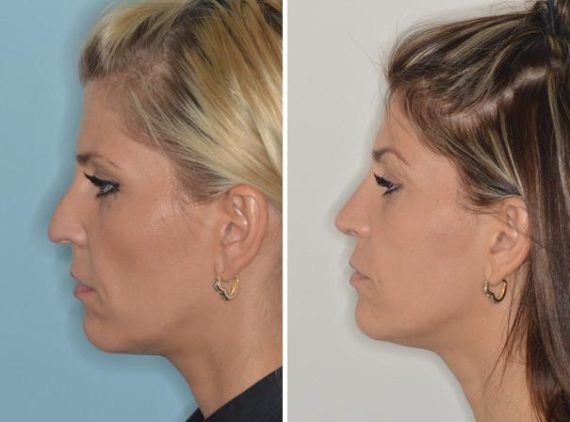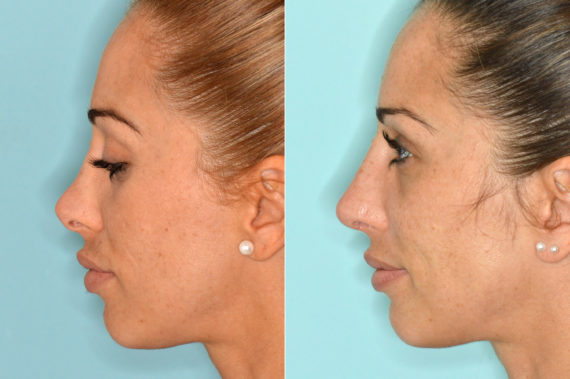Addressing the Retracted Nostril in Revision Rhinoplasty
As a facial plastic surgeon, Dr. Bared understands the importance of addressing alar retraction and the effect it has on nostril shape. When a patient has issues with nasal tip retraction and an altered nostril shape, revision rhinoplasty is often necessary to restore a natural and aesthetically pleasing appearance.
What is a Retracted Nostril?
Many patients who see Dr. Bared for their Miami revision rhinoplasty procedure have the complaint that they have a retracted nostril or too much nostril shown on the profile view. The retracted nostril is a very challenging issue to address in revision rhinoplasty. It can be due to the actual nostril retracting or also a long columella (the central part of the nose). The combination of both these entities leads to too much nostril showing on the profile view. This can be an unattractive finding with the nose and it may lead patients to seek a revision rhinoplasty.
The entity of a retracted ala is typically not a concern found in isolation with revision rhinoplasty. It is commonly found along with other findings contributing to what is known as the foreshortened nose. The foreshortened nose is the term for when a combination of factors is seen after a rhinoplasty. These findings can be a scooped or low dorsum, an upturned tip, and excessive columellar show.
Causes of Retracted Nostril
When a patient has excess nostril show, this can be due to previous surgeries or alar cartilage issues. Previous surgeries such as a primary rhinoplasty may have included an over-resection of the lower lateral cartilage, which is responsible for maintaining the shape of the nose. If too much tissue is removed, this can lead to a retracted nostril.
Another cause of alar retraction is when the alar cartilage itself is weak or distorted. In some cases, it may be necessary to reconstruct the alar cartilage to restore a natural appearance. Regardless of the cause, facial plastic surgeons like Dr. Bared need to understand and address both existing and potential causes of retracted nostrils during revision rhinoplasty surgery to achieve a successful outcome.
Revision rhinoplasty transcends the correction of retracted nostrils, encompassing a holistic approach to rectify a spectrum of nasal deformities. It meticulously addresses the harmony of the entire nose, including the correction of a deviated septum, dorsal hump reduction, and tip refinement, ensuring a balanced and proportionate outcome. This comprehensive strategy not only enhances the nasal function but also ensures that the aesthetic goals of the patient align with the structural integrity of the nose.
Consultation for a Revision Rhinoplasty
During your consultation for a revision rhinoplasty, Dr. Bared will take a thorough medical history and listen to your exact concerns about your nose. It also helps if you bring a list of questions to your consult in this way you can ensure that all your questions will be addressed. Before meeting with Dr. Bared, you will visit one of his patient advisors who will begin to explain to you the process of your potential revision rhinoplasty Miami.
Dr. Bared will perform a thorough nasal examination to assess and examine both the outside and inside of your nose. He will then sit with you and review each of your concerns and expectations from a procedure to ensure that the goals are mutual and realistic. During your consultation, you can also expect Dr. Bared to perform a detailed series of photos of your nose from various angles and with proper lighting.
Eyebrow Transplantation
Before & After Photos
Each patient is unique and individual results may vary*.
Computer imaging for revision rhinoplasty
Dr. Bared performs computer imaging on the photos he takes during your consultation to help better communicate the goals of the surgery. Computer imaging for Dr. Bared is not used as a “sales tool” nor is it used to give false expectations. Instead, it is used solely as another means of communication. Through imaging, Dr. Bared can portray to you an idea of the potential results from a surgery and then he can also assess if this meets your expectations and goals.
The key to any cosmetic surgery is first performing a procedure that is in the best interest of the patient. Dr. Bared has the best interest in mind for each patient he treats and he tries his best to meet the expectations from a procedure.
Pre-Operative Considerations for Revision Rhinoplasty with Retracted Nostrils
Before any revision rhinoplasty, it is important to evaluate the nostril rims and nasal septum for proper symmetry. Depending on the type of rhinoplasty, the surgeon may need to recreate or reshape the nostril rims to restore balance. The surgeon should also assess whether a cartilage graft or an alar rim graft is needed to reinforce the nostril rims or if sutures are sufficient for reshaping them. Furthermore, if there are issues regarding the nasal septum, such as deviation or asymmetry, these must be addressed as part of the surgical plan.
Revision Rhinoplasty Surgery for Nostril Retraction
Revision rhinoplasty is the most challenging procedure in cosmetic surgery. The reason for it being so complicated is that the anatomy of the nose under the skin is not normal and scar tissue is present. Great results can be achieved with revision rhinoplasty Miami in the hands of a rhinoplasty surgeon who is very experienced and knowledgeable in the specialty.
An expert rhinoplasty surgeon needs to be able to handle the unknown anatomy of the nose in a revision case. The retracted ala is most likely a result of the surgical weakening of the cartilages which make up the nasal tip. These cartilages which make up the nasal tip are referred to as the lower lateral cartilages. To adequately address this issue the cartilages need to be reinforced with cartilage grafts. Revision rhinoplasty for retracted nostrils demands meticulous surgical precision. The procedure typically involves the careful harvest and transplantation of cartilage grafts to bolster the weakened nasal rim. This is often achieved using composite grafts, which are strategically placed to support and lower the nostril rim, improving both the nasal contour and functionality. Special attention is given to the delicate balance between the nasal tip and alar base to ensure a natural-looking outcome. By employing advanced suture techniques and ensuring optimal cartilage placement, we aim to restore not only the aesthetic harmony of the nose but also its essential respiratory functions. With the use of these grafts, the cartilage can then be repositioned to a more natural and less retracted position.

In some cases, arched nostril rims may be needed to restore the natural curvature of the nose. For more severe cases, a composite graft made from cartilage and skin may be used to reconstruct the nostril rim and improve the shape of the nostril aperture. Rhinoplasty incisions are typically made in the columella, which is between the nostrils, as well as inside each nostril for access to reshape or augment any area of concern.
Recovery after a Nostril Revision Surgery
Revision rhinoplasty patients require a longer healing process than those who have had primary rhinoplasty. This is because the nose has already experienced trauma from the previous surgery and must now be reconstructed. To ensure proper healing, revision rhinoplasty patients need to follow their post-operative instructions.
After surgery, there will be swelling and bruising around the eyes and nose, as well as discomfort in the area of the nostril tissue. It is important to keep your head elevated and practice breathing through your mouth to reduce swelling. Additionally, it is important to avoid strenuous activities while your body adjusts and heals following revision rhinoplasty Miami Beach. The typical recovery time for this procedure can range anywhere from six weeks up to three months, depending on the patient’s circumstances.
Schedule an appointment with a Rhinoplasty Expert!
If you are considering revision rhinoplasty and are searching for a skilled surgeon who is experienced in advanced rhinoplasty techniques, look no further than Dr. Bared. He is a Miami-based, double-board certified facial plastic surgeon with expertise in all aspects of rhinoplasty and reconstructive nasal surgery. To schedule an appointment with Dr. Bared to discuss your revision rhinoplasty needs, call his office today!



